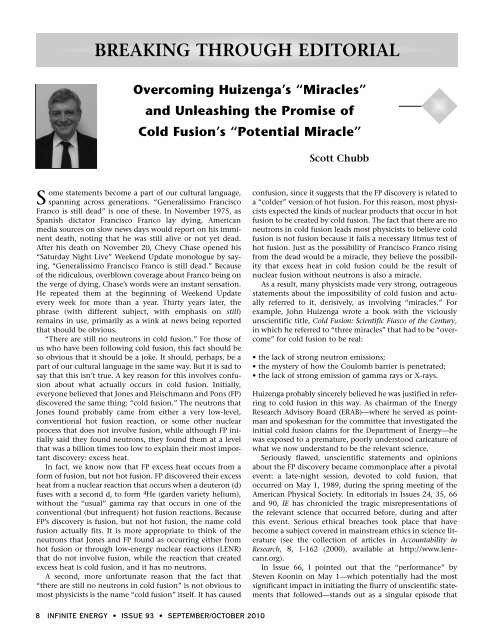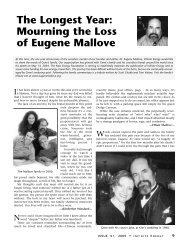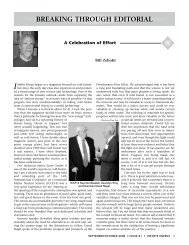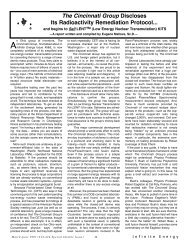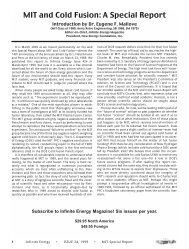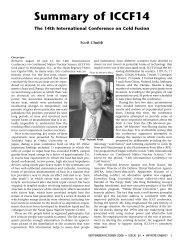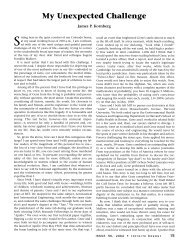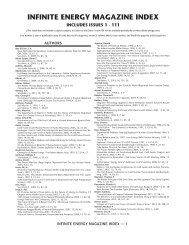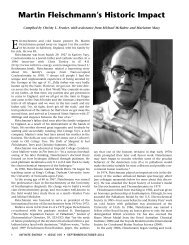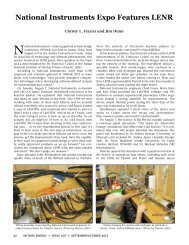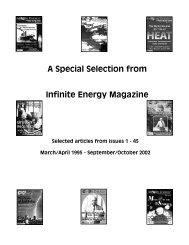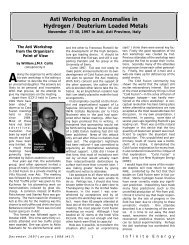Overcoming Huizenga's "Miracles" - Infinite Energy Magazine
Overcoming Huizenga's "Miracles" - Infinite Energy Magazine
Overcoming Huizenga's "Miracles" - Infinite Energy Magazine
Create successful ePaper yourself
Turn your PDF publications into a flip-book with our unique Google optimized e-Paper software.
BREAKING THROUGH EDITORIAL<br />
<strong>Overcoming</strong> Huizenga’s “Miracles”<br />
and Unleashing the Promise of<br />
Cold Fusion’s “Potential Miracle”<br />
Scott Chubb<br />
Some statements become a part of our cultural language,<br />
spanning across generations. “Generalissimo Francisco<br />
Franco is still dead” is one of these. In November 1975, as<br />
Spanish dictator Francisco Franco lay dying, American<br />
media sources on slow news days would report on his imminent<br />
death, noting that he was still alive or not yet dead.<br />
After his death on November 20, Chevy Chase opened his<br />
“Saturday Night Live” Weekend Update monologue by saying,<br />
“Generalissimo Francisco Franco is still dead.” Because<br />
of the ridiculous, overblown coverage about Franco being on<br />
the verge of dying, Chase’s words were an instant sensation.<br />
He repeated them at the beginning of Weekend Update<br />
every week for more than a year. Thirty years later, the<br />
phrase (with different subject, with emphasis on still)<br />
remains in use, primarily as a wink at news being reported<br />
that should be obvious.<br />
“There are still no neutrons in cold fusion.” For those of<br />
us who have been following cold fusion, this fact should be<br />
so obvious that it should be a joke. It should, perhaps, be a<br />
part of our cultural language in the same way. But it is sad to<br />
say that this isn’t true. A key reason for this involves confusion<br />
about what actually occurs in cold fusion. Initially,<br />
everyone believed that Jones and Fleischmann and Pons (FP)<br />
discovered the same thing: “cold fusion.” The neutrons that<br />
Jones found probably came from either a very low-level,<br />
conventional hot fusion reaction, or some other nuclear<br />
process that does not involve fusion, while although FP initially<br />
said they found neutrons, they found them at a level<br />
that was a billion times too low to explain their most important<br />
discovery: excess heat.<br />
In fact, we know now that FP excess heat occurs from a<br />
form of fusion, but not hot fusion. FP discovered their excess<br />
heat from a nuclear reaction that occurs when a deuteron (d)<br />
fuses with a second d, to form 4 He (garden variety helium),<br />
without the “usual” gamma ray that occurs in one of the<br />
conventional (but infrequent) hot fusion reactions. Because<br />
FP’s discovery is fusion, but not hot fusion, the name cold<br />
fusion actually fits. It is more appropriate to think of the<br />
neutrons that Jones and FP found as occurring either from<br />
hot fusion or through low-energy nuclear reactions (LENR)<br />
that do not involve fusion, while the reaction that created<br />
excess heat is cold fusion, and it has no neutrons.<br />
A second, more unfortunate reason that the fact that<br />
“there are still no neutrons in cold fusion” is not obvious to<br />
most physicists is the name “cold fusion” itself. It has caused<br />
confusion, since it suggests that the FP discovery is related to<br />
a “colder” version of hot fusion. For this reason, most physicists<br />
expected the kinds of nuclear products that occur in hot<br />
fusion to be created by cold fusion. The fact that there are no<br />
neutrons in cold fusion leads most physicists to believe cold<br />
fusion is not fusion because it fails a necessary litmus test of<br />
hot fusion. Just as the possibility of Francisco Franco rising<br />
from the dead would be a miracle, they believe the possibility<br />
that excess heat in cold fusion could be the result of<br />
nuclear fusion without neutrons is also a miracle.<br />
As a result, many physicists made very strong, outrageous<br />
statements about the impossibility of cold fusion and actually<br />
referred to it, derisively, as involving “miracles.” For<br />
example, John Huizenga wrote a book with the viciously<br />
unscientific title, Cold Fusion: Scientific Fiasco of the Century,<br />
in which he referred to “three miracles” that had to be “overcome”<br />
for cold fusion to be real:<br />
• the lack of strong neutron emissions;<br />
• the mystery of how the Coulomb barrier is penetrated;<br />
• the lack of strong emission of gamma rays or X-rays.<br />
Huizenga probably sincerely believed he was justified in referring<br />
to cold fusion in this way. As chairman of the <strong>Energy</strong><br />
Research Advisory Board (ERAB)—where he served as pointman<br />
and spokesman for the committee that investigated the<br />
initial cold fusion claims for the Department of <strong>Energy</strong>—he<br />
was exposed to a premature, poorly understood caricature of<br />
what we now understand to be the relevant science.<br />
Seriously flawed, unscientific statements and opinions<br />
about the FP discovery became commonplace after a pivotal<br />
event: a late-night session, devoted to cold fusion, that<br />
occurred on May 1, 1989, during the spring meeting of the<br />
American Physical Society. In editorials in Issues 24, 35, 66<br />
and 90, IE has chronicled the tragic misrepresentations of<br />
the relevant science that occurred before, during and after<br />
this event. Serious ethical breaches took place that have<br />
become a subject covered in mainstream ethics in science literature<br />
(see the collection of articles in Accountability in<br />
Research, 8, 1-162 (2000), available at http://www.lenrcanr.org).<br />
In Issue 66, I pointed out that the “performance” by<br />
Steven Koonin on May 1—which potentially had the most<br />
significant impact in initiating the flurry of unscientific statements<br />
that followed—stands out as a singular episode that<br />
8 INFINITE ENERGY • ISSUE 93 • SEPTEMBER/OCTOBER 2010
was and is an embarrassment to the APS and to everyone who<br />
was involved. Since writing my comments about this, I have<br />
come to more fully appreciate how damaging Koonin’s initial<br />
comments were by being able to see his presentation online<br />
(http://www.youtube.com/watch?v=wR-AohRWbBo),<br />
through material posted by Steven Krivit.<br />
In 1989, Koonin was a professor of theoretical physics at<br />
CalTech. Subsequently he became a provost at CalTech, then<br />
chief scientist at BP, and was appointed by Barack Obama to<br />
serve as DOE Under Secretary of <strong>Energy</strong> for Science.<br />
As Under Secretary, Koonin is responsible for overseeing<br />
the DOE Office of Science and DOE’s national laboratories<br />
and is responsible for managing the Science Office’s $6 billion<br />
research budget. He plays a dominant role in funding<br />
research and development in energy generally and alternative<br />
energy in particular.<br />
During his May 1 “performance,” Koonin was blunt and<br />
derisive: “My conclusion based on my experience, my<br />
knowledge of nuclear physics, and my intuition is that the<br />
[cold fusion] experiments are just wrong and that we’re suffering<br />
from the incompetence and perhaps delusion of Drs.<br />
Pons and Fleischmann.” He also said, “We have no reliable<br />
report of reproduction of these experiments, despite strenuous<br />
effort by many groups around the world who bring to<br />
bear resources and expertise far greater than Pons and<br />
Fleischmann had to do this. Moreover, even the people at<br />
Harwell, who have Professor Fleischmann as a consultant,<br />
have been unable to reproduce the effect.”<br />
Koonin was utterly and completely wrong in these assertions<br />
about excess heat. Fleischmann is one of the foremost<br />
electrochemists in the world and continues to be the foremost<br />
expert in measuring the excess heat effects that he and<br />
others measured in the kinds of experiments that he conducted.<br />
Because an incubation time lasting as long as six<br />
weeks is frequently necessary in excess heat experiments,<br />
Koonin questioning the reliability of these experiments was<br />
premature since he raised this issue only five weeks after the<br />
initial FP announcement. Ironically, even his comment<br />
about Harwell being unable to reproduce the effect is incorrect;<br />
a later analysis by Hansen and Melich indicates there<br />
was evidence of excess heat in the Harwell experiments<br />
(http://www.lenr-canr.org/acrobat/mMelichMEsomelesson.pdf).<br />
Koonin concluded his APS talk by mocking the cold<br />
fusion claims by Fleischmann and Pons, using an irrelevant,<br />
irreverent Aesop Fable, in which he likened their claims to<br />
an exaggerated claim by “The Boasting Traveler”: “A certain<br />
man who visited foreign lands could talk of little when he<br />
returned home, except the wonderful adventures he had met<br />
with and the great deeds he had done abroad. One of the<br />
feats he told about was a leap he had made in a city called<br />
Rhodes. That leap was so great, he said, that no other man<br />
could leap anywhere near the distance. A great many persons<br />
in Rhodes had seen him do it and would prove that<br />
what he told was true. ‘No need of witnesses,’ said one of the<br />
hearers. Suppose this city is Rhodes. Now show us how far<br />
you can jump.’” Koonin used the fable to imply that it was<br />
necessary to “witness” cold fusion, in person, to believe it.<br />
In fairness to Koonin, the possibility of a radiation-less,<br />
aneutronic fusion reaction that releases ordinary, gardenvariety<br />
helium was not on anyone’s radar screen. Virtually<br />
all mainstream physicists thought that the effect, if it was<br />
real, had to involve some exotic form of electronic screening,<br />
associated with a palladium or titanium lattice, and that<br />
neutrons had to be created.<br />
I made my comments about Koonin’s presentation in<br />
Issue 66, by chance, just before I had a brief confrontation<br />
with him after a talk he gave about future energy during the<br />
March 2006 meeting of the APS. During the exchange, it<br />
became apparent his views have changed since 1989. After<br />
his talk, I invited him to attend the cold fusion session the<br />
following day. He said: “So, here’s what I think about condensed<br />
matter nuclear science. BP pays me to pay attention<br />
to lots of technologies...And we have money to invest...And<br />
they pay me to make judgments about that, okay? For better<br />
or worse, I have decided that’s not something that I want to<br />
be investing in right now. You know, if I make a wrong call,<br />
I’ll lose my job.” Then, he said, “Let me say that there are a<br />
lot of people in the venture capital business who are just<br />
hungry for energy technologies. I hope one of them picks it<br />
up and then pursues [it].”<br />
In fact, the patent office has embargoed cold fusion<br />
patents. They justify this by claiming that cold fusion<br />
devices fall into the same category as perpetual motion<br />
machines. For this reason, although “people in the venture<br />
capital business [might be] hungry for energy technologies,”<br />
they are not “hungry” enough to fund cold fusion.<br />
Obviously, at the time, Koonin was not aware of this fact.<br />
Steven Krivit taped the exchange; it is available online<br />
(http://www.newenergytimes.com/v2/audio/2006Chubb-<br />
Versus-Koonin-March17.mp3). Bob Bass covered it in Issue<br />
67, expressing his optimism about potential cold fusion<br />
funding from a new initiative that Congress had recently<br />
approved. It involved the creation of a new office, the<br />
Advanced Research Projects Agency (ARPA-E), whose mission<br />
would be to “support ground-breaking energy<br />
research.” Congress had also stipulated that this new office<br />
would “report to the Under Secretary for Science” (the position<br />
that Steven Koonin now holds).<br />
Almost universally, today, funding agencies—including<br />
ARPA-E—and science journals ignore cold fusion. Papers and<br />
proposals are rejected without review or are reviewed by people<br />
who do not believe cold fusion is real. These problems<br />
reflect a more major problem, resulting from cold fusion<br />
being rejected by the scientific Establishment.<br />
An argument can be made that John Huizenga’s “miracles”<br />
are not insurmountable at all, and that they have been<br />
overcome through the normal process of science, while the<br />
“scientific fiasco” that he suggested actually never took place<br />
but merely reflects a perception that occurred as a result of<br />
preconceptions and biases that resulted from the lack of<br />
information that was available to the individuals who were<br />
involved with the ERAB committee.<br />
Ironically and, in fact, arguably, “Huizenga’s Miracles”<br />
have been useful to cold fusion and LENR theorists. In particular,<br />
as opposed to believing these “miracles” have to be<br />
“overcome,” theorists have used the three statements that he<br />
posed as a starting point for creating relevant, appropriate<br />
theories of the effects. Instead of the major political, economic<br />
or social changes that have been suggested, it may be<br />
possible to change the existing climate by informing physicists<br />
that the initial picture they had for rejecting cold fusion<br />
is wrong. This could be as simple as saying, “Just as<br />
Generalissimo Francisco Franco is still dead, there are still no<br />
neutrons in cold fusion.”<br />
SEPTEMBER/OCTOBER 2010 • ISSUE 93 • INFINITE ENERGY 9
In an introductory talk at the July 2010 Colloquium on<br />
Lattice-Assisted Nuclear Reactions (LANR) at MIT, Dr.<br />
Mitchell Swartz provided an overview of the reasons that the<br />
“promise” of cold fusion includes a “potential miracle.” He<br />
illustrated this using a concrete example: energy consumption<br />
in the city of Boston. He estimated that in Boston, the<br />
average daily consumption of energy from electricity requires<br />
the equivalent of 54,000 tons of coal. He pointed out that<br />
cold fusion could potentially lead to technologies that could<br />
produce the equivalent amount of energy from 6 pounds<br />
(three-quarters of a gallon) of heavy water. Even more astonishing<br />
are the environmental implications. Each day, burning<br />
the amount of coal associated with consuming this energy<br />
would create 180,000 tons of CO 2 , 3,600 tons of SO 2 and<br />
480 tons of NO 2 . In contrast, to produce the same amount of<br />
energy, cold fusion would create 24 garbage size bags of an<br />
entirely pollution-free product—ordinary helium gas.<br />
A number of new, important results were presented at the<br />
colloquium. These included reports by Dr. Swartz about: 1)<br />
New, innovative procedures for producing electricity, directly<br />
from nuclear processes involving nanometer scale size<br />
electrodes, in electrolysis experiments, and inducing similar<br />
electrical effects from nuclear processes, using ultrasound, in<br />
these kinds of materials; 2) Discovery of a new effect involving<br />
sudden variations in resistance that can accompany<br />
these processes and can be used to develop a new kind of<br />
Zener diode; and 3) Identification of new effects and procedures<br />
for characterizing and reproducing excess heat, using<br />
analytical tools associated with relating input power to<br />
important parameters associated with the nuclear processes.<br />
Dr. Swartz also provided important information about the<br />
potential impact of heavy water additions in experiments<br />
involving Ni and light water that suggests that excess heat in<br />
these systems may be the result of the kinds of d+d cold<br />
fusion reactions that occur in FP electrolysis experiments.<br />
Dr. Brian Ahern reported that using samples provided by<br />
Yoshiaki Arata, he has created excess heat six times, in six<br />
attempts, in gas-loading experiments involving the procedure<br />
that Arata has developed. This issue includes a condensed<br />
report of this meeting (p. 16), but an in-depth summary<br />
appears on our website.<br />
To unleash the “promise” of “cold fusion’s miracle” (outlined<br />
in Dr. Swartz’s talk) is not a miracle at all. It simply<br />
requires that the kind of sound scientific research that has<br />
been taking place in the field for the last 21 years continue.<br />
Provided that adequate funding occurs, there is every reason<br />
to believe this will happen. The developments that were presented<br />
during the 2010 Colloquium at MIT suggest that considerable<br />
progress will be made as the implications of using<br />
nanometer materials in these experiments are more fully<br />
understood.<br />
ARPA-E receives $100 million each year to fund research<br />
efforts that “accelerate innovation in green technology,<br />
increase America’s competitiveness and create new jobs.” In<br />
response to ARPA-E’s first solicitation, a number of CMNS<br />
researchers submitted proposals. To my knowledge, ARPA-E<br />
did not fund any of these proposals. A number of researchers<br />
have suggested that because Steve Koonin directly oversees<br />
ARPA-E, his negative attitude and statements about cold<br />
fusion in the past have had a negative impact on these funding<br />
decisions. Whether or not this is true is an open question.<br />
However, it is clear that although in his capacity as BP<br />
chief scientist in 2006, Koonin had justification for his recommendation<br />
that funding cold fusion-related research<br />
might be too risky for BP to undertake, at the present time,<br />
in his present role, he cannot justify ARPA-E’s failure to<br />
invest in cold fusion for this reason. Indeed, ARPA-E is supposed<br />
to be modeled after the DOD’s Defense Advanced<br />
Research Projects Administration (DARPA), which not only<br />
is required to fund new, potentially risky areas of research,<br />
but has funded cold fusion-related projects in the past.<br />
The potential pay-off, which involves the development of<br />
new, ultra-clean energy sources that are as much as 20 million<br />
times more efficient than the ones that are used today,<br />
is so revolutionary that ARPA-E’s decision to not fund cold<br />
fusion research must be questioned.<br />
I urge Under Secretary Steven Koonin to support cold<br />
fusion as one of the breakthrough technologies worthy of<br />
support by the ARPA-E program. This would make clear that<br />
he is in step with the current progress in the field and<br />
remove any misunderstanding about his current position.<br />
With this proposal in mind, if you are from the United<br />
States, I urge you to contact Under Secretary Steve Koonin,<br />
DOE Secretary Steven Chu, Presidential Science Advisor John<br />
Holdren and your Congressman and Senators and ask for<br />
their support of ARPA-E funding of cold fusion research:<br />
Office of Science and Technology Policy<br />
Attn: Dr. John Holdren<br />
725 17th Street Room 5228<br />
Washington, DC 20502<br />
Email: askdrh@ostp.gov<br />
U.S. Department of <strong>Energy</strong><br />
Attn: Under Secretary Steve Koonin<br />
Attn: Secretary Steven Chu<br />
1000 Independence Avenue SW<br />
Washington, DC 20585<br />
Email: The.Secretary@hq.doe.gov<br />
❑ ❑ ❑ ❑<br />
The Science of Low <strong>Energy</strong> Nuclear Reaction:<br />
A Comprehensive Compilation of Evidence and<br />
Explanations About Cold Fusion<br />
by Edmund Storms<br />
This long-awaited book by prominent<br />
cold fusion researcher Dr. Edmund<br />
Storms catalogues and evaluates the evidence<br />
for cold fusion and shows why the<br />
initial reaction to cold fusion was driven<br />
more by self-interest than fact.<br />
(Hardcover, 2007, 312 pages)<br />
$85.00 North America<br />
$100.00 Foreign<br />
Prices include shipping.<br />
New <strong>Energy</strong> Foundation • P.O. Box 2816 • Concord, NH 03302-2816<br />
Phone: 603-485-4700 • Fax: 603-485-4710<br />
www.infinite-energy.com<br />
10 INFINITE ENERGY • ISSUE 93 • SEPTEMBER/OCTOBER 2010


